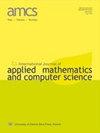A Feasible Schedule for Parallel Assembly Tasks in Flexible Manufacturing Systems
IF 1.2
4区 计算机科学
Q3 AUTOMATION & CONTROL SYSTEMS
International Journal of Applied Mathematics and Computer Science
Pub Date : 2022-03-01
DOI:10.34768/amcs-2022-0005
引用次数: 4
Abstract
Abstract The paper concerns the design of a framework for implementing fault-tolerant control of hybrid assembly systems that connect human operators and fully automated technical systems. The main difficulty in such systems is related to delays that result from objective factors influencing human operators’ work, e.g., fatigue, experience, etc. As the battery assembly system can be considered a firm real-time one, these delays are treated as faults. The presented approach guarantees real-time compensation of delays, and the fully automated part of the system is responsible for this compensation. The paper begins with a detailed description of a battery assembly system in which two cooperating parts can be distinguished: fully automatic and semi-automatic. The latter, nonderministic in nature, is the main focus of this paper. To describe and analyze the states of the battery assembly system, instead of the most commonly used simulation, the classic max-plus algebra with an extension allowing one to express non-deterministic human operators’ work is used. In order to synchronize tasks and schedule (according to the reference schedule) automated and human operators’ tasks, it is proposed to use a wireless IoT platform called KIS.ME. As a result, it allows a reference model of human performance to be defined using fuzzy logic. Having such a model, predictive delays tolerant planning is proposed. The final part of the paper presents the achieved results, which clearly indicate the potential benefits that can be obtained by combining the wireless KIS.ME architecture (allocated in the semi-automatic part of the system) with wired standard production networks.柔性制造系统中并行装配任务的可行调度
摘要:本文设计了一个框架,用于实现连接人工操作人员和全自动技术系统的混合装配系统的容错控制。这种系统的主要困难是由于影响操作人员工作的客观因素造成的延迟,例如疲劳、经验等。由于电池装配系统可以被认为是一个稳定的实时系统,这些延迟被视为故障。所提出的方法保证了延迟的实时补偿,并且系统的全自动化部分负责这种补偿。本文首先详细描述了一种电池装配系统,该系统可以区分为全自动和半自动两种合作部分。后者在本质上是非女性的,是本文的主要焦点。为了描述和分析电池装配系统的状态,本文采用经典的max-plus代数来代替最常用的仿真方法,并对其进行了扩展,使其能够表达不确定的人工操作。为了同步任务和调度(根据参考时间表)自动化和人工操作员的任务,建议使用名为kiss . me的无线物联网平台。因此,它允许使用模糊逻辑定义人类表现的参考模型。有了这样的模型,提出了预测容忍延迟规划。论文的最后部分给出了所取得的结果,这些结果清楚地表明了结合无线KIS可以获得的潜在好处。ME架构(分配在系统的半自动部分),采用有线标准生产网络。
本文章由计算机程序翻译,如有差异,请以英文原文为准。
求助全文
约1分钟内获得全文
求助全文
来源期刊
CiteScore
4.10
自引率
21.10%
发文量
0
审稿时长
4.2 months
期刊介绍:
The International Journal of Applied Mathematics and Computer Science is a quarterly published in Poland since 1991 by the University of Zielona Góra in partnership with De Gruyter Poland (Sciendo) and Lubuskie Scientific Society, under the auspices of the Committee on Automatic Control and Robotics of the Polish Academy of Sciences.
The journal strives to meet the demand for the presentation of interdisciplinary research in various fields related to control theory, applied mathematics, scientific computing and computer science. In particular, it publishes high quality original research results in the following areas:
-modern control theory and practice-
artificial intelligence methods and their applications-
applied mathematics and mathematical optimisation techniques-
mathematical methods in engineering, computer science, and biology.

 求助内容:
求助内容: 应助结果提醒方式:
应助结果提醒方式:


